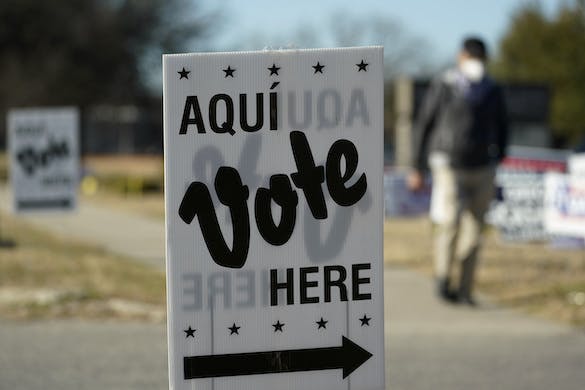The Surprising Wing of the Emerging Republican Majority
Latinos are starting to look like a pivotal feature of the emerging multiracial Republican coalition. This stands at odds with decades of conventional wisdom among Democrats.

Democrats are in trouble in 2022. Inflation, crime, and persistent Covid alarmism all point toward an imminent red wave. What’s more, the party’s numbers are sagging among a particular demographic — and for many, this is an unexpected struggle.
Latinos are starting to look like a pivotal feature of the emerging multiracial Republican coalition. This stands at odds with decades of conventional wisdom among Democrats that immigration-driven demographic change would move the country’s electorate leftward, even in traditionally Republican strongholds.
“Hispanics,” the progressive publication Latino Decisions wrote in October 2020, “will turn Texas blue if given a chance.”
Similar views were widely held to be true across the country: John B. Judis and Ruy Teixeira’s famous “emerging Democratic majority” thesis predicted that the growing Latino share of the American electorate — now the largest share of nonwhite voters in America — would push the nation’s politics to the left.
President Trump proved otherwise during the 2020 election, carrying Texas by an easy five-and-a-half-point margin, in no small part because of the rightward movement of the Latino vote.
Five of the nation’s six biggest county-level shifts toward Mr. Trump in 2020 versus 2016 occurred in the heavily Hispanic Rio Grande region of south Texas. In Starr County, which is 99 percent Latino, Mr. Trump improved his performance by 55 points.
Similar results are being seen across America. As I wrote in December, Mr. Trump increased his support among Latinos by about eight points in 2020 versus 2016, and far more dramatic swings were recorded in certain areas. Florida’s Miami-Dade County, which is 68 percent Hispanic, swung toward Trump by 22 points, for example.
More recently, Republican Glenn Youngkin beat his Democratic opponent, Terry McAuliffe, outright with Hispanics in the Virginia gubernatorial race.
Meanwhile, the across-the-board decline in President Biden’s approval ratings has been sharpest among Hispanics. As of the end of October, it was sitting below 40 percent.
In the face of these trends, Messrs. Judis and Teixeira have pulled back on their “emerging Democratic majority” thesis. “If Hispanic voting trends continue to move steadily against the Democrats, the pro-Democratic effect of nonwhite population growth will be blunted, if not canceled out entirely, and that very influential Democratic theory of the case falls apart,” Mr. Texeira wrote in a recent blog post. “That could—or should—provoke quite a sea change in Democratic thinking.”
Mr. Judis had started sounding the alarm as far back as 2017. In an essay that ran in the New Republic under the headline, “Redoing the Electoral Math,” he wrote, “History shows that as ethnic groups assimilate into American culture, they increasingly identify themselves as ‘white,’” warning that “whiteness is not a genetic category” but “a social and political construct.”
As a result, he continued, “there’s no reason to imagine that Latinos and Asians won’t follow much the same pattern” as the Irish, Italians, and Jews who came to be viewed by many as “white” despite not originally being seen as such when they first arrived on American shores. “In fact, it’s already happening,” Mr. Judis wrote. “In the 2010 Census, 53 percent of Latinos identified as ‘white’ … in future generations, those percentages are almost certain to grow. According to a recent Pew study, more than one-quarter of Latinos … marry non-Latinos … and that number will surely continue to climb over the generations.”
In other words, Hispanics are assimilating. They’re becoming American. And just like with the white-ethnic immigrants who arrived at Ellis Island in the first quarter of the 20th century, the assimilation process is pushing them away from their traditional loyalty to the Democratic Party — and toward a new friendliness to the GOP.
It’s no wonder, then, that a December Wall Street Journal poll found that Hispanics are now evenly split between the two parties, with 37 percent polling in support of both Democrats and Republicans, respectively. (Twenty-two percent were undecided). “Latinos are more and more becoming swing voters.… They’re a swing vote that we’re going to have to fight for,’’ John Anzalone, a Democratic pollster whose company helped conduct the poll, told the Journal.
Mr. Anzalone’s correct. The only question is whether his party will notice in time.
In fact, recent polling has poked holes in the narratives about Latino voters that predominate on both the left and the right. In elite Republican strategist circles, conventional wisdom long held that the party would need to moderate on cultural issues — and particularly immigration — to reach Latinos. The RNC’s famous “autopsy,” released on the heels of the party’s losses in the 2012 election, called for the GOP to “embrace and champion comprehensive immigration reform.” (What that meant, of course, was amnesty, worker visas, and open borders — policies that just so happened to be what many of the party’s special interests and donors already favored). “If we do not,” the autopsy argued, “our Party’s appeal will continue to shrink to its core constituencies only.”
That turned out to be incorrect, too. Mr. Trump, of all people — arguably the staunchest immigration hawk to be nominated by either party in recent memory — initiated the beginnings of the long-foretold multiracial, working-class Republican coalition. In his own haphazard, chaotic way, the former president reached communities that more conventional Republican candidates could not.
And this wasn’t in spite of Mr. Trump’s stance on immigration. Far from it. According to a new report from the Democratic polling firm Equis Research, 55 percent of Latinos who voted in the 2020 election favor more spending on border security. What’s more, 51 percent support limiting refugees and asylum-seekers, and 49 percent are for reducing the rate of legal immigration.
In other words, on immigration and many other issues, Latinos are not the liberals that both Republican and Democrat elites seemed to assume they were. That presents a real opportunity for Republicans up and down the ballot in 2022 and beyond.

